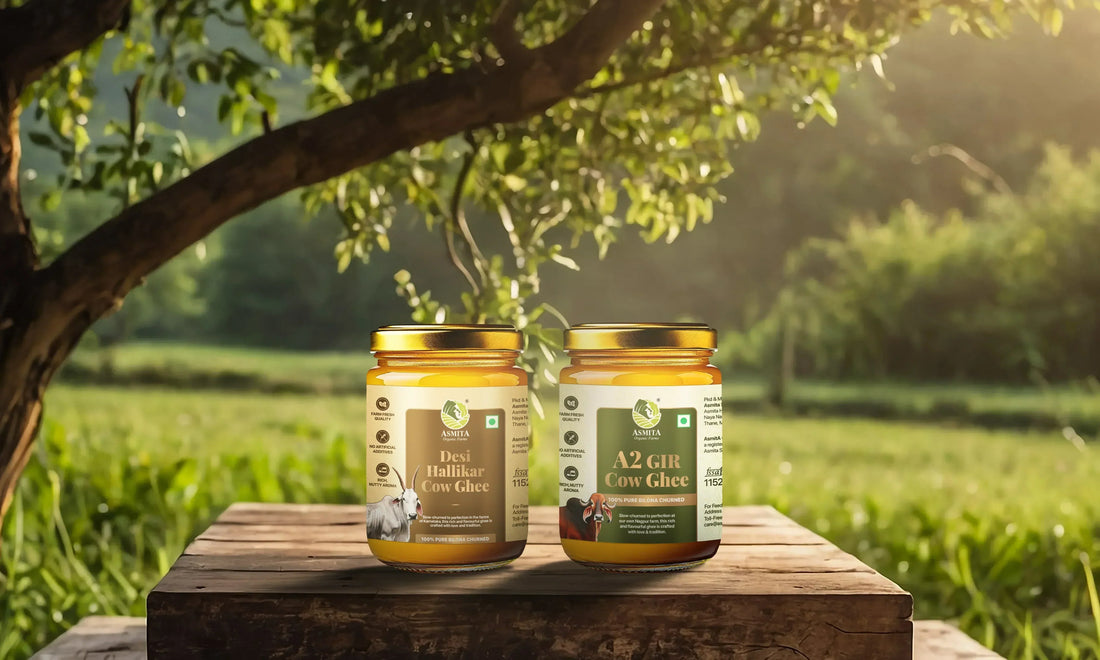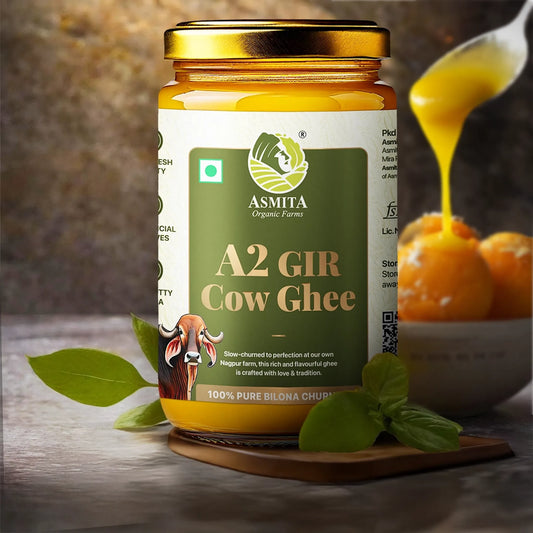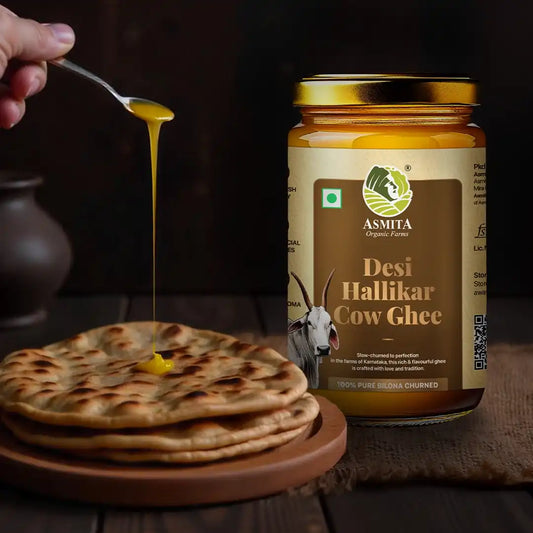Cow Ghee vs Buffalo Ghee: Which is Better?
5 min read
Ghee has been a part of Indian families for thousands of years. Besides being used for cooking, ghee is valued for its robust flavour, health benefits according to Ayurvedic medicine, and significance in religious observances.
Nevertheless, some people wonder about cow ghee vs buffalo ghee, and which one to consume. Let’s learn the differences between the two and make it an easy pick for you.
Table of Contents
1. Cow Ghee vs Buffalo Ghee: Which One Should You Choose
2. Nutritional Comparison
3. Cow Ghee vs Buffalo Ghee Benefits
4. Taste and Cooking Comparison
5. Which Should You Prefer Based on Uses
6. How to Choose the Right Ghee
7. Bottom Line
8. FAQs
Cow Ghee vs Buffalo Ghee: Which One Should You Choose
Which ghee is better, cow or buffalo, usually depends on an individual’s needs.
While certain individuals appreciate how quickly their body processes cow ghee, others prefer the dense buffalo ghee, which retains its nutrition for a longer period. Ayurvedically, cow ghee helps bring about calm and serenity, but buffalo ghee has heavier qualities that help build muscles.
Instead of declaring a winner between cow ghee vs buffalo ghee, let’s see how they compare.
Nutritional Comparison
Whether the milk for ghee has been taken from a buffalo or cow (plus, the variety of cow) determines the nutrient profile of the ghee. Here’s an easy comparison of the nutritional value of cow ghee and buffalo ghee:
|
Property |
Cow Ghee |
Buffalo Ghee |
|
Fat Content |
Lower than buffalo ghee; approx 7.9g/serving saturated fat |
Higher, nearly 100% fat, more calorie-dense |
|
Type of Fat |
More monounsaturated fats (healthier for the heart) |
Higher saturated fat; thicker and richer |
|
Vitamins |
Rich in vitamins A, D, E, K |
Contains vitamins A, D, E, and K, but is higher in A and D |
|
Minerals |
Calcium, minerals, protein, and antioxidants |
Calcium, magnesium, phosphorus, potassium, selenium |
|
Conjugated Linoleic Acid (CLA) |
Higher, aids metabolism and weight management |
Present but less than cow ghee |
|
Butyric Acid |
High, supports gut health and digestion |
Present and also aids digestion |
|
Colour |
Yellow (due to beta-carotene) |
White |
Cow Ghee vs Buffalo Ghee Benefits
Each type of ghee has its unique health benefits.
|
Benefits of Cow Ghee |
Benefits of Buffalo Ghee |
|
You can digest it easier, because it contains less fat, and it’s softer on the stomach. |
Ideal for those with high energy demand, such as athletes and labourers. |
|
Thanks to vitamin A, for the health of your vision and immune system. |
Strengthens the body and spirit. Ayurvedic vajikarana therapy often includes it. |
|
Cow ghee can activate your digestion, helping your body get more nutrients. |
Great for skin and massage, as it helps tone the muscle tension. |
Taste and Cooking Comparison
Now that you’re aware of the difference between cow ghee and buffalo ghee, let’s understand how they taste and how to cook them.
Cow ghee emits a flavour, sweetness, and a mild aroma. It tastes well with many foods such as dal, khichdi, and halwa. With a smoke point of 250 °C, it can be used for sautéing and shallow frying.
Buffalo ghee has a richer texture and even stronger flavour than cow ghee. Its higher thickness and whiter appearance make it easier to spot in your food. Because its smoke point is slightly higher than cow ghee, it works well for deep-frying.
Which Should You Prefer Based on Uses
Here’s a quick guide for you to make your pick:
Choose cow ghee if you’re using it for:
- Sedentary or low exercise level lifestyle
- Making meals for children or elderly family members
- Want to lose or control weight
Buffalo ghee is ideal if you:
- Work out or play sports, you must increase your calorie intake
- Want to look after your skin and muscles
- Like having flavour in what you eat
How to Choose the Right Ghee
To pick the right ghee, it is essential to consider its ingredients and uses. Look for the following:
- Always ensure you get A2 cow ghee that is not processed with preservatives. You can choose from AsmitA Organic Farms’ A2 Gir Cow Ghee and A2 Desi Hallikar Cow Ghee.
- Nutrients are better saved when using bilona (churning curd) instead of commercial cream-based methods. This is what AsmitA Organic Farms follows while making the best quality ghee.
- Keep your ghee safe by choosing a product packed in either glass jars or contamination-free plastic containers.
Bottom Line
Both cow and buffalo ghee offer important health benefits, although they are designed for different individuals. The benefits of cow ghee make it a perfect choice for those seeking a versatile option suitable for various ages and most homemade recipes.
Explore AsmitA Organic Farms’ A2 Cow Ghee—crafted using the bilona method, free from preservatives, and packed in safe, eco-conscious containers. Grab your jar now and taste the difference.
FAQs
1. Which is better: cow ghee or buffalo ghee?
The nutritional value of cow ghee supports digestion well and is intended for regular use as well as cooking that requires little fat. If you’re looking for more calories and energy for activities, Buffalo ghee is the best choice.
2. Is cow ghee better for weight loss?
Yes, cow ghee can be beneficial for people attempting to lose weight. Even so, be mindful of your serving sizes.
3. Can we use buffalo ghee for babies?
Buffalo ghee is generally not recommended for babies, as their digestive system is not yet fully developed.
4. Does buffalo ghee increase cholesterol?
In general, buffalo ghee doesn’t lead to high cholesterol. In fact, it is a healthier fat than many other processed ones. However, if consumed excessively, it can increase cholesterol levels due to its saturated fat content. So, moderation is the key.












